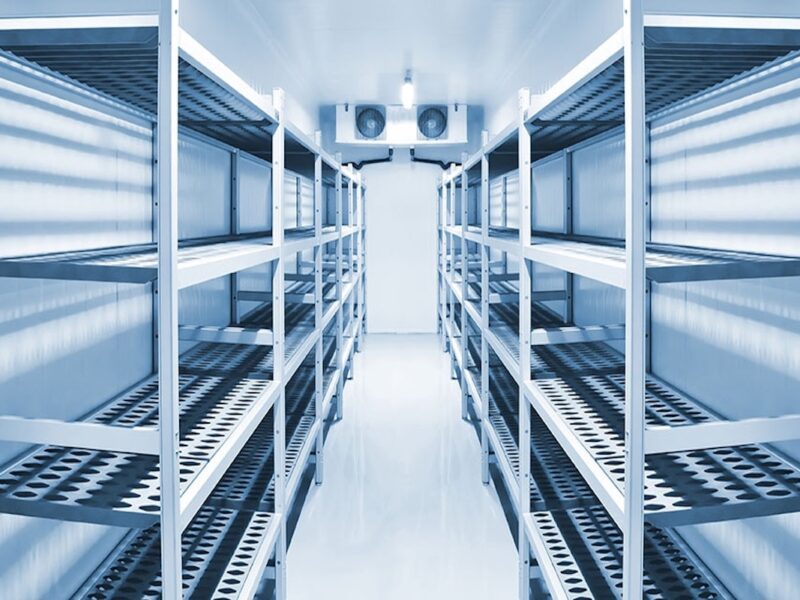
Freezing Panels; How They Are The Need Of The Hour
A majority of freezer room panels are insulated with polyurethane foam (also called PUR) and are sheathed by metal on both sides. Lately, polyisocyanurate foam or PIR has become very popular. Like polyurethane foam, PIR possesses characteristics of thermal insulation. Also, at the same time, it has a higher resistance to fire and has erosivity index of 30 (EI30). Fireproof partitions are generally made using PIR. Some panels have increased polystyrene insulation (EPS) which is also the expected thermal insulation of cold rooms.
What They Are Made Of
Polystyrene whose insulation has been enhanced can be used to insulate freezer rooms but the thermal conductivity of foam is about 1.5 to 2 times higher. For this reason, the thickness of the panel must be selected at least 20-30% more than that for polyurethane foam sandwich panels.
Basalt sandwich panels or mineral wool used a lot in construction are not the right material when it comes to the thermal insulation of refrigerating and freezing chambers due to their ability to absorb a higher amount of moisture. This leads to moisture impregnation and in turn gives rise to rapid loss of the properties of thermal insulation of the material. Additionally, the characteristics of this material are lower than those of polyurethane foam.
If the buyer is ordering small volumes of heat-insulating sandwich panels, they have to keep in mind that panels of standard lengths would be offered and they would also need to buy sandwich panels. While custom-made panels can be bought, they will take a longer time to get delivered than readymade panels.
Panel Selection Criteria
Regarding the thickness of the panel, some important parameters have to be kept in consideration:
- The maximum difference between the temperature inside the chamber and outside the temperature.
- In rooms that have higher humidity, the thickness of the thermal insulation has to be increased to prevent condensation on the panel surface.
- Another parameter is the presence or absence of solar radiation, that is direct sunlight, like outdoor installations, or sunlight through an indoor window.
Specialists can take into account even more parameters and make calculations of the required thickness of the panel that is required for cooling chambers. In regular cases, the thickness can be in the range of:
- 80mm panel for cold storage (medium range of temperature between +10 to -5C).
- 100mm panel for the freezer (low temperature of -15C or -20C).
Basics Of Freezing Panels
Freezer panels are constructed of insulation that is between the ‘skin’ of the metal. The skin is often made using stainless steel or galvanized steel. The freezing room will start to malfunction if the panels are inefficiently made. The insulation layer has a thickness of about 4 inches and possesses high foam insulation. The insulation protects the cooler from loss of temperature and will no doubt up the efficiency of the room. Freezer panels in Melbourne can be found easily as they are in big demand in the city and almost throughout the world.
Distinguishing Between Panels
Type & Thickness
A metal sheathing that has a thickness of 0.5mm if the customer is price-conscious. If bought directly from manufacturers, the thickness they will offer would be even less but due to the reduction in thickness, the rigidity will take a beating and will be prone to getting dents during installation and operation. Ceiling panels can bend. A workable thickness for the panels that can be installed and worked long-term is 0.55mm to 0.7mm. Some foreign manufacturers offer a thickness of 0.8mm but they are more expensive.
The price of PPU panels varies on the quality of the metal. Panels are made using galvanized sheathing with paints and varnishes, plasticizing, and coatings of other types. Resistance to corrosion and the life of the material depends on the material used. Galvanized unpainted metal sheaths can be bought to make extra savings but it is only accepted for external coating and installation inside dry rooms.
Thermal Insulation Power
The thermal insulation quality can be found by its thermal conductivity characteristic. This characteristic fluctuates around 0.019-0.025 W*K/m for polyurethane. The thermal insulation would be higher as this figure goes down. Expanded polystyrene insulation or EPS is a cheaper material that can be used for comparison as it has a thermal conductivity of 0.038 * K/m. The structure of the PUR has to be porous and uniform throughout the panel throughout the volume of the panel in its entirety.
What Are Vapour Barriers
The purpose of vapour barriers is to prevent the condensation of moisture from migrating to the wall. The wall is constructed keeping a certain balance in mind to make way for drying when condensation occurs. This is done to prevent rots. Condensation can take place on both sides of the panel. There can be vapour barriers on the external surface of the panel but the location of the same will vary from construction to construction. If you are in Melbourne and want to get freezer panels installed, then you can look them up on Google by simply typing ‘Freezer panels in Melbourne’.
Conclusion
The demand for freezer rooms is growing steadily because they enjoy enough renown for their insulating properties. A freezer room can be an excellent agent to save significant amounts of money as a lot of it is spent on cooking. The panel inside the room helps to control the temperature of the interior of the room with less use of energy and makes the temperature of the same stable.





